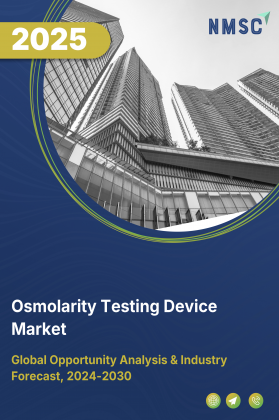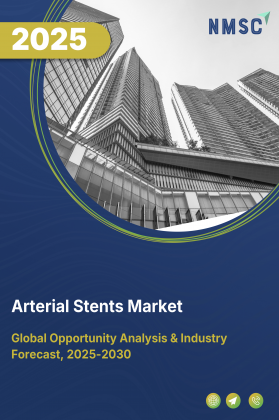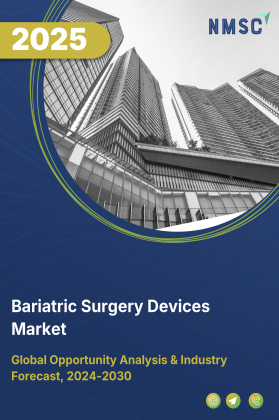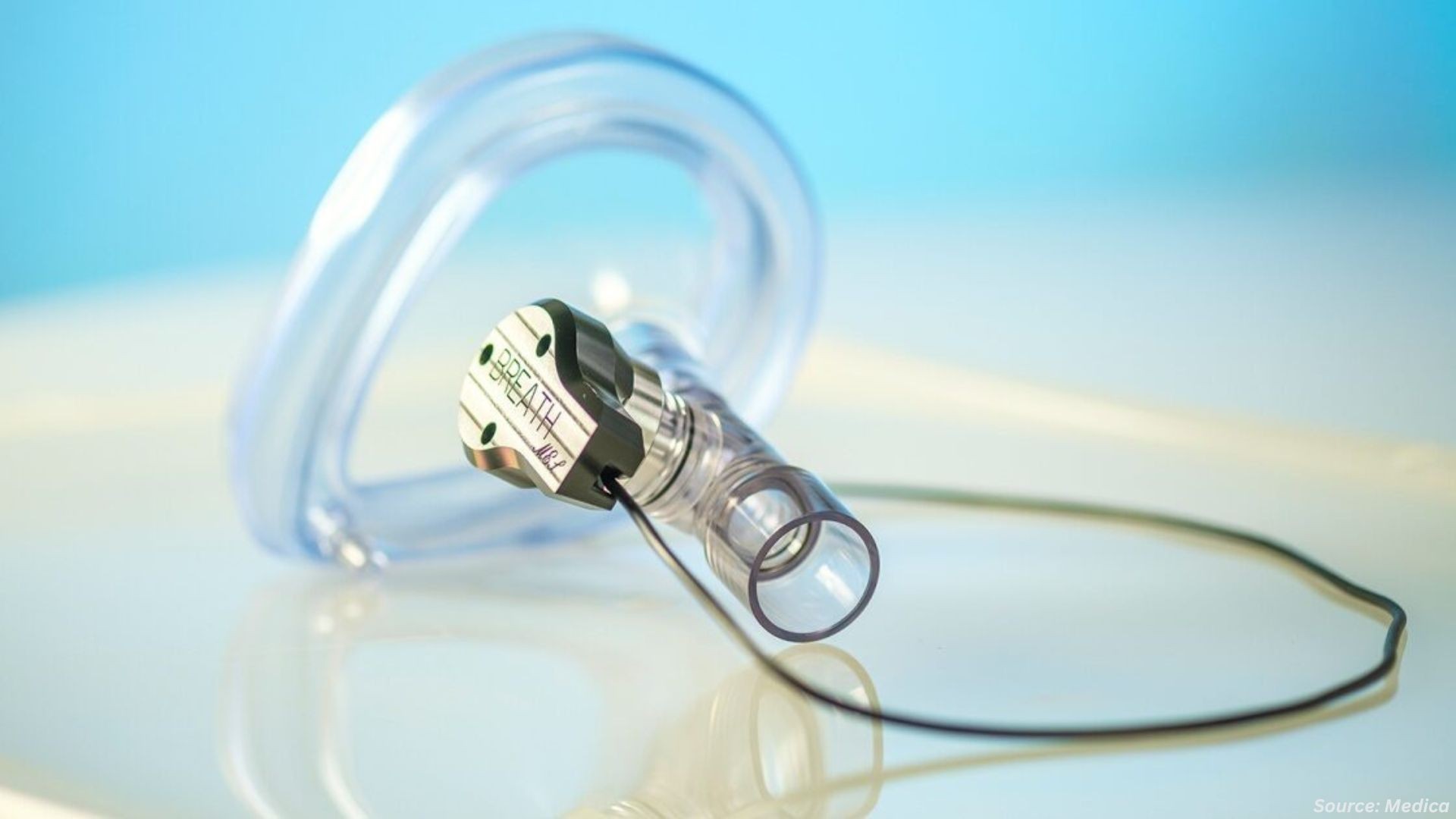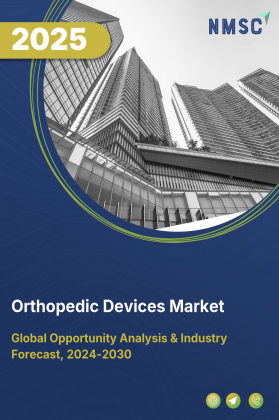
Orthopedic Devices Market by Material (Metals, Polymers, Ceramics, Composites), by Product Type (Joint Reconstruction Implants, Spinal Implants, Others), by Technology (Conventional, Minimally Invasive, Robotic-Assisted, Smart Implants, 3D-Printed), by Application (Degenerative Disorders, Others), and by End User (Hospitals, Ambulatory Surgical Centers, Specialty Clinics, Rehabilitation Facilities, Home Care, Others) – Global Opportunity Analysis and Industry Forecast, 2025–2030.
Industry Overview
The global Orthopedic Devices Market size was valued at USD 70.12 billion in 2024, with an estimation of USD 73.91 billion in 2025 and is predicted to reach USD 96.14 billion by 2030 with a CAGR of 5.40% from 2025-2030.
The market is experiencing significant growth, driven by the rising geriatric population, increasing incidence of musculoskeletal disorders, and a surge in trauma and sports-related injuries. Age-related conditions such as osteoarthritis, osteoporosis, and degenerative disc disease are fueling demand for joint replacements and spinal implants.
Additionally, the global rise in obesity is contributing to early-onset orthopedic issues, increasing the need for surgical interventions and durable implants. Growing participation in high-impact sports and rising accident rates have led to greater demand for trauma fixation devices and sports-specific orthopedic solutions.
However, high treatment costs and limited access in emerging economies continue to hinder widespread adoption. Despite these challenges, the market is seeing strong opportunities in minimally invasive and robotic-assisted procedures, which offer improved outcomes and faster recovery. As outpatient surgeries become more commo
The global Orthn, particularly in ambulatory surgical centers, innovation in smart implants and advanced surgical tools is expected to further accelerate the orthopedic devices market expansion.
Rising Geriatric Population and Age-Related Musculoskeletal Disorders Fuels Market Growth
The steadily increasing elderly population worldwide is a major catalyst for the orthopedic devices market growth. According to the World Health Organization (WHO), the number of people aged 60 years and older is expected to rise from 1 billion in 2020 to 1.4 billion by 2030 and 2.1 billion by 2050.
Elderly individuals are more prone to musculoskeletal conditions like osteoarthritis, osteoporosis, rheumatoid arthritis, and degenerative disc disease. These chronic conditions require medical interventions such as hip and knee replacements, spinal fusion devices, and bone cement, significantly contributing to the demand for orthopedic products.
High Incidence of Traumatic Injuries and Sports-Related Accidents Boosts Market Expansion
The global rise in physical activity, particularly in high-impact sports, adventure tourism, and fitness training, has led to a sharp increase in musculoskeletal injuries such as fractures, dislocations, and ligament tears. Alongside this, the growing number of vehicular collisions, industrial accidents, and falls among the elderly has significantly boosted the demand for orthopedic trauma fixation devices, including plates, rods, pins, screws, and external fixators.
For instance, the World Health Organization (WHO) identifies road traffic injuries as the leading cause of death for individuals aged 5–29 years, with millions sustaining non-fatal injuries that require orthopedic intervention. The urgent need for surgical repair and accelerated recovery in trauma cases has driven the adoption of advanced trauma implants that support faster rehabilitation and mobility restoration.
Furthermore, the expansion of sports medicine and the establishment of orthopedic sports injury clinics have further increased the demand for specialized implants designed for athlete-specific procedures such as ACL reconstruction, shoulder stabilization, and ankle fixation surgeries. Innovations in bioabsorbable implants, arthroscopic tools, and customized orthopedic solutions continue to fuel strong sales across trauma-related orthopedic segments.
Surge in Obesity and Lifestyle-Related Orthopedic Problems Drives Market Expansion
Obesity directly contributes to the development and progression of orthopedic disorders, particularly in the form of joint degeneration, spinal complications, and limited mobility. The World Obesity Federation projects that by 2035, over 4 billion people, or 51% of the global population, will be classified as overweight or obese.
Excess body weight places continuous mechanical stress on weight-bearing joints such as the knees, hips, and lower spine, accelerating cartilage breakdown and triggering conditions like early-onset osteoarthritis, herniated discs, and postural imbalances. As obesity rates continue to rise globally, the burden on orthopedic systems is intensifying driving higher demand for surgical interventions, mobility aids, and durable orthopedic implants.
High Cost of Advanced Orthopedic Treatments Limits the Market Growth
Despite rising demand, the adoption of orthopedic devices is hindered by the high cost of surgical procedures and advanced implants, especially in regions with underdeveloped healthcare systems. Many orthopedic interventions, such as joint replacements, spinal implants, and arthroscopic surgeries, require specialized equipment, skilled professionals, and post-operative rehabilitation, all of which contribute to the overall treatment burden.
In several emerging economies, the lack of comprehensive reimbursement policies and limited insurance coverage further restricts patient access. As a result, a large segment of the population delays or avoids orthopedic treatment, impacting overall industry penetration. These financial and systemic barriers pose a significant challenge to widespread adoption, particularly in price-sensitive and underserved markets.
Rising Demand for Minimally Invasive and Robotic-Assisted Orthopedic Procedures Unlocks New Growth Opportunities
The rising demand for minimally invasive and robotic-assisted orthopedic procedures present a major opportunity in the orthopedic devices market demand. These advanced surgical techniques offer benefits such as reduced pain, shorter hospital stays, faster recovery, and lower complication rates compared to traditional open surgeries.
As a result, procedures like joint replacements and spinal surgeries are increasingly being performed in outpatient settings, particularly ambulatory surgical centers (ASCs). Robotic-assisted systems, such as MAKO and ROSA, further enhance precision, implant alignment, and patient outcomes.
This shift toward technologically advanced, less invasive care is driven by aging populations, growing patient preference for quicker recovery, and the need for cost-effective solutions. Manufacturers that invest in developing smart implants, navigation tools, and 3D-printed surgical components stand to gain significant market share by meeting the evolving clinical and operational demands of orthopedic care providers.
Market Segmentations and Scope of the Study
The orthopedic devices market report is segmented by material, product type, technology, application, end user, and region. Materials include metals such as titanium and cobalt-chrome, polymers like UHMWPE and PEEK. Product types comprise joint reconstruction implants, spinal implants, trauma fixation devices, craniomaxillofacial devices, orthobiologics, soft tissue repair products, prosthetics, orthotics, and surgical tools. Technologies include conventional systems, minimally invasive procedures, robotic-assisted platforms, smart implants, and 3D-printed solutions. Applications range across degenerative conditions, traumatic injuries, deformities, sports injuries, oncology, and pediatric disorders. End users include hospitals, ambulatory surgical centers, specialty clinics, rehabilitation facilities, and home care settings. Geographically, the market covers North America, Europe, Asia-Pacific, and the Rest of the World.
Geographical Analysis
A key driver for the market in North America is the high and growing prevalence of musculoskeletal disorders, including osteoarthritis, rheumatoid arthritis, spinal stenosis, and traumatic injuries. According to the U.S. Bone and Joint Initiative, nearly one in two adults in the United States is affected by a musculoskeletal condition, leading to increased demand for joint reconstruction, spinal implants, trauma fixation devices, and orthobiologics.
The aging population, especially the large baby boomer demographic, further contributes to this trend as the incidence of degenerative joint diseases rises with age. This sustained clinical burden is driving hospitals, ambulatory surgical centers, and specialty clinics across the region to adopt advanced orthopedic solutions, fueling steady market growth.
The steadily increasing elderly population across Europe is a key factor driving growth in the orthopedic devices market share, particularly in joint replacement procedures such as hip and knee implants. As life expectancy rises in countries like Germany, France, Italy, and the UK, the prevalence of age-related musculoskeletal conditions such as osteoarthritis continues to grow.
According to Eurostat, over 21% of the EU population is aged 65 or older, and this proportion is expected to increase further. This demographic shift is placing greater pressure on healthcare systems to offer effective orthopedic solutions, encouraging investments in advanced implants, minimally invasive surgical tools, and postoperative rehabilitation technologies. As a result, aging demographics are significantly boosting the adoption of orthopedic devices across both public and private healthcare facilities throughout Europe.
A major driver of the market in Asia-Pacific is the strengthening of medical infrastructure and the growing accessibility of orthopedic services across developing and developed nations in the region. Countries such as China, India, Indonesia, and Vietnam are witnessing increased government and private sector investment in hospitals, specialty clinics, and surgical centers, particularly in urban and semi-urban regions. This has led to greater availability of orthopedic procedures, including joint replacements, spinal surgeries, and trauma treatments.
Additionally, rising income levels, growing health awareness, and an increasing elderly population are contributing to higher demand for advanced orthopedic solutions. The region is also seeing greater adoption of minimally invasive and cost-effective technologies, making orthopedic care more accessible to a broader population. These developments are collectively propelling market growth throughout the Asia-Pacific region.
In the Rest of the World (RoW) region, which includes Latin America, the Middle East, and Africa, a key driver of the market is the increasing incidence of trauma cases and road traffic accidents. Additionally, improving emergency care infrastructure, expanding insurance coverage, and growing investments in healthcare systems are enabling more patients to access orthopedic treatments. As awareness of advanced orthopedic procedures spreads and governments prioritize trauma care in public health agendas, the adoption of orthopedic devices is expected to rise steadily across these emerging markets.
Strategic Innovations Adopted by Key Players
Key players in the orthopedic devices industry are accelerating growth through targeted acquisitions, next-generation product launches, and technological innovation.
-
In July 2025, Zimmer announced plans to acquire Monogram Technologies (approx. USD 177 million), which specializes in semi-/fully autonomous knee replacement robotics, strengthening its surgical robotics line-up.
-
In June 2025, Stryker received FDA clearance for its Incompass Total Ankle System, a new data‑driven implant platform combining its Inbone and Infinity systems, designed for total ankle replacement in cases of severe arthritis or trauma.
-
In March 2025, Stryker unveiled its fourth-generation Mako robotic system (Mako 4) at AAOS 2025, including new options for hip revision, spine, and shoulder procedures. They also secured FDA clearance for a hip revision feature, a first for a surgical robot, alongside the updated Mako platform.
-
In January 2025, Zimmer Biomet acquired Paragon 28 for USD 1.1 billion, expanding its range of foot, ankle, trauma, and joint replacement implants.
-
In January 2025, Stryker sold its U.S. spinal implants business to Viscogliosi Brothers (forming VB Spine, LLC), marking a strategic shift to focus resources on other segments.
-
In February 2025, Medtronic acquired nano-surface technology assets from Nanovis (OsteoSync titanium pads) to enhance osseointegration and fixation for its PEEK interbody fusion implants.
Key Benefits
-
The market report provides quantitative analysis and estimations of the industry from 2024 to 2030, which assists in identifying the prevailing market opportunities.
-
The study comprises a deep-dive analysis of the current and future orthopedic devices market trends to depict prevalent investment pockets in the sector.
-
Information related to key drivers, restraints, and opportunities and their impact on the market is provided in the report.
-
Competitive analysis of the players, along with their market share is provided in the report.
-
SWOT analysis and Porter's Five Forces model is elaborated in the study.
-
Value chain analysis in the market study provides a clear picture of the roles of stakeholders.
Orthopedic Devices Market Key Segments
By Product Type
-
Implants
-
Joint Reconstruction
-
Knee
-
Hip
-
Shoulder
-
Ankle
-
Elbow
-
-
Spine Implants
-
Fusion and Cages
-
Screws and Rods
-
Motion Preservation
-
-
Trauma Fixation Implants
-
Intramedullary Nails
-
Plates and Screws
-
External Fixation Systems
-
-
Sports Medicine Implants
-
Soft Tissue Anchors
-
Meniscal Devices
-
Ligament Repair Implants
-
-
Dental and CMF Implants
-
Pediatric Implants
-
-
Surgical Instruments
-
Reusable Instrument Sets
-
Single Use Instrument Kits
-
Power Tools and Hand Instruments
-
Arthroscopy Instrument Sets
-
Patient Specific Instruments (PSI)
-
-
Capital Systems
-
Surgical Navigation Systems
-
Robotic Assisted Systems
-
Intraoperative Imaging Systems
-
Operating Room Tables and Supports
-
-
Orthotics and Prosthetics
-
Lower Limb Prostheses
-
Upper Limb Prostheses
-
Braces and Supports
-
Foot Orthoses and Insoles
-
Custom Orthotics
-
-
Consumables and Disposables
-
Sutures and Staples
-
Single Use Instruments and Kits
-
Dressings Casts and Splints
-
Drill Bits Burrs and Blades
-
-
Components and Accessories
-
Modular Implant Components and Liners
-
Instrument Trays and Cases
-
Replacement Parts and Repair Kits
-
By Technology and Material
-
Metal Alloys
-
Polymers and Composites
-
Ceramics
-
Additive Manufactured Implants (3D Printed)
-
Coated and Surface Engineered Implants
-
Connected and Smart Devices
By Regulatory and Risk Class
-
Implantable High Risk Devices
-
Non Implantable Medium Risk Devices
-
Low Risk Consumables and Disposables
By End User
-
Hospitals Inpatient Surgery
-
Ambulatory Surgery Centers (ASC)
-
Orthopedic Clinics
-
Trauma Centers
-
Rehabilitation Centers
-
Home Care and DME
-
Dental and Maxillofacial Clinics
By Region
-
North America
-
The U.S.
-
Canada
-
Mexico
-
-
Europe
-
The UK
-
Germany
-
France
-
Italy
-
Spain
-
Denmark
-
Netherlands
-
Finland
-
Sweden
-
Norway
-
Russia
-
Rest of Europe
-
-
Asia-Pacific
-
China
-
Japan
-
India
-
South Korea
-
Australia
-
Indonesia
-
Singapore
-
Taiwan
-
Thailand
-
Rest of Asia-Pacific
-
-
RoW
-
Latin America
-
Middle East
-
Africa
-
Key Players
-
DePuy Synthes (Johnson Johnson)
-
Stryker Corporation
-
Zimmer Biomet Holdings Inc
-
Smith and Nephew plc
-
Medtronic plc
-
Arthrex Inc
-
Enovis Corporation (includes LimaCorporate)
-
Globus Medical Inc
-
MicroPort Scientific Corporation
-
B Braun Melsungen AG Aesculap
-
CONMED Corporation
-
Orthofix Medical Inc
-
Medacta International SA
-
OrthoPediatrics Corp
-
Exactech Inc
-
Alphatec Holdings Inc ATEC
-
Corin Group
-
Integra LifeSciences Holdings Corporation
-
Weigao Group Co Ltd (WEGO)
-
AK Medical Holdings Limited
Report Scope and Segmentation
|
Parameters |
Details |
|
Market Size in 2025 |
USD 73.91 Billion |
|
Revenue Forecast in 2030 |
USD 96.14 Billion |
|
Growth Rate |
CAGR of 5.40% from 2025 to 2030 |
|
Analysis Period |
2025–2030 |
|
Base Year Considered |
2024 |
|
Forecast Period |
2025–2030 |
|
Market Size Estimation |
Billion (USD) |
|
Growth Factors |
|
|
Countries Covered |
28 |
|
Companies Profiled |
20 |
|
Market Share |
Available for 10 companies |
|
Customization Scope |
Free customization (equivalent up to 80 working hours of analysts) after purchase. Addition or alteration to country, regional, and segment scope. |
|
Pricing and Purchase Options |
Avail customized purchase options to meet your exact research needs. |

















 Speak to Our Analyst
Speak to Our Analyst



